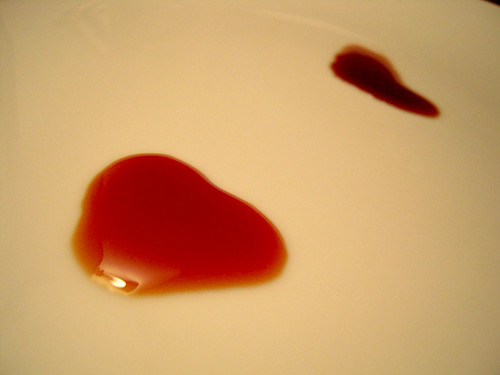
I was always baffled by
tamari. I had never used it until one of my friends and faithful readers of UM suggested that I should write about
tamari vs.
shoyu (soy sauce) on Japanify.
So this week, I purchased San-J brand's
Tamari (I chose that brand because I happened to have San-J brand's Organic
Shoyu stocked in my pantry right now).
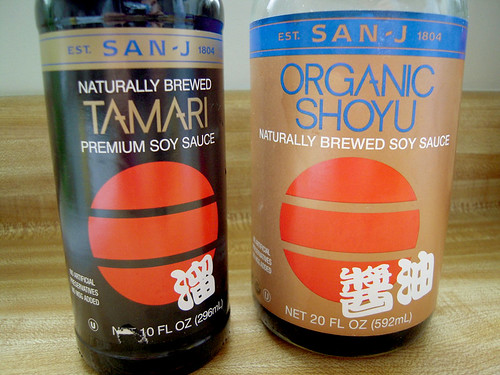 Tamari
Tamari comes from the word "tamaru" in Japanese which means "collect, gather or accumulate."
Tamari was originally a liquid byproduct of the miso-making process (which involves fermenting soybeans, which apparently the Japanese do in many many ways). Essentially, fermenting miso "sweats off"
tamari.
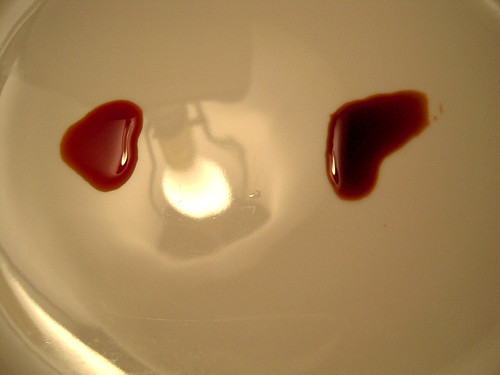 Tamari (left), Shoyu (right)
Tamari (left), Shoyu (right)
While
shoyu is made out of roughly 50% soybeans and 50% wheat,
tamari is made with little or no wheat - so it's a good
shoyu substitute for people who are allergic to wheat. The result for
tamari is a much thicker and milder sauce than soy sauce. But remember, both types are produced from the fermentation process.
While the unapologetically and piercingly salty
shoyu is the best choice for sushi and sashimi,
tamari is ideal for sauces and dressings for more depth and umami. I have yet to try making tsuyu with
tamari, but I can predict that it will be a better choice than
shoyu.
A taste comparison I did was for a salad that I am lately pretty into making. Canned tuna, garbanzo beans dressed in Japanese mayo,
shoyu/
tamari, EVOO and black pepper. The dressing was good with
shoyu, but rounder and more agreeable with
tamari. After making the same salad while substituting
shoyu for
tamari, I finally understood why
tamari might work better in certain situations.
This was my salad:
3 handfuls of
mizuna
5 okra sliced (optional)
1/2 cup of garbanzo beans
1 canned tuna/salmon
Dressing
1 tbsp
tamari
1 tbsp EVOO
2 tbsp Japanese mayo
salt and pepper to taste
Mix canned fish and garbanzo beans into a mixing bowl.
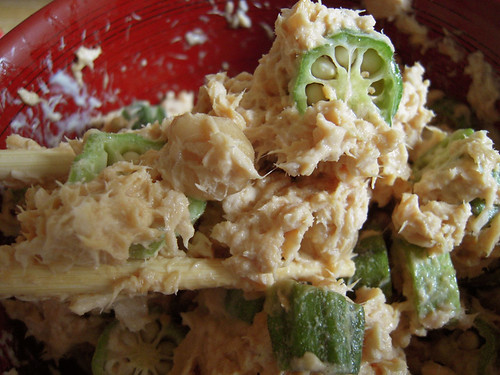
Add dressing ingredients into the bowl and mix well.
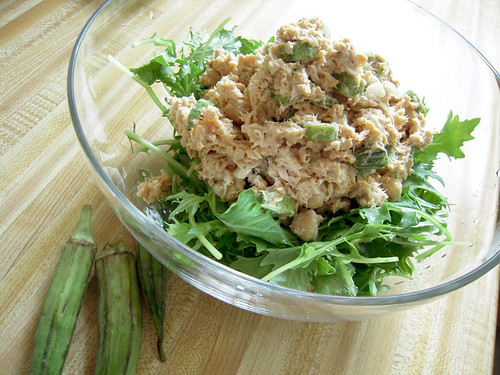
Slice okra and wash mizuna. Place mizuna and okra in a big salad bowl. Then add the fish mixture to the salad bowl and toss. The fish mixture may clump together so don't be shy to use your hands to toss the salad and coat the mizuna leaves well.
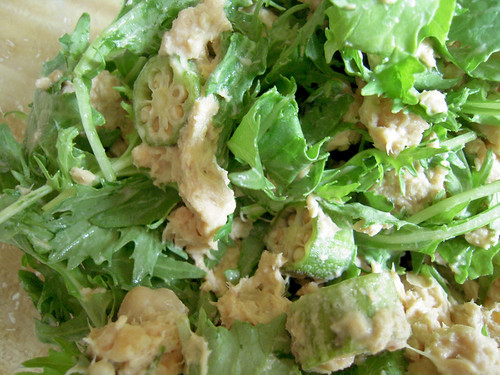
The
tamari was perfect in the salad, which didn't overpower the delicate mizuna leaves. It was also a perfect accent to the raw okra which can taste a little... well - raw.
 I was always baffled by tamari. I had never used it until one of my friends and faithful readers of UM suggested that I should write about tamari vs. shoyu (soy sauce) on Japanify.
So this week, I purchased San-J brand's Tamari (I chose that brand because I happened to have San-J brand's Organic Shoyu stocked in my pantry right now).
I was always baffled by tamari. I had never used it until one of my friends and faithful readers of UM suggested that I should write about tamari vs. shoyu (soy sauce) on Japanify.
So this week, I purchased San-J brand's Tamari (I chose that brand because I happened to have San-J brand's Organic Shoyu stocked in my pantry right now).
 Tamari comes from the word "tamaru" in Japanese which means "collect, gather or accumulate." Tamari was originally a liquid byproduct of the miso-making process (which involves fermenting soybeans, which apparently the Japanese do in many many ways). Essentially, fermenting miso "sweats off" tamari.
Tamari comes from the word "tamaru" in Japanese which means "collect, gather or accumulate." Tamari was originally a liquid byproduct of the miso-making process (which involves fermenting soybeans, which apparently the Japanese do in many many ways). Essentially, fermenting miso "sweats off" tamari.
 Tamari (left), Shoyu (right)
While shoyu is made out of roughly 50% soybeans and 50% wheat, tamari is made with little or no wheat - so it's a good shoyu substitute for people who are allergic to wheat. The result for tamari is a much thicker and milder sauce than soy sauce. But remember, both types are produced from the fermentation process.
While the unapologetically and piercingly salty shoyu is the best choice for sushi and sashimi, tamari is ideal for sauces and dressings for more depth and umami. I have yet to try making tsuyu with tamari, but I can predict that it will be a better choice than shoyu.
A taste comparison I did was for a salad that I am lately pretty into making. Canned tuna, garbanzo beans dressed in Japanese mayo, shoyu/tamari, EVOO and black pepper. The dressing was good with shoyu, but rounder and more agreeable with tamari. After making the same salad while substituting shoyu for tamari, I finally understood why tamari might work better in certain situations.
This was my salad:
3 handfuls of mizuna
5 okra sliced (optional)
1/2 cup of garbanzo beans
1 canned tuna/salmon
Dressing
1 tbsp tamari
1 tbsp EVOO
2 tbsp Japanese mayo
salt and pepper to taste
Mix canned fish and garbanzo beans into a mixing bowl.
Tamari (left), Shoyu (right)
While shoyu is made out of roughly 50% soybeans and 50% wheat, tamari is made with little or no wheat - so it's a good shoyu substitute for people who are allergic to wheat. The result for tamari is a much thicker and milder sauce than soy sauce. But remember, both types are produced from the fermentation process.
While the unapologetically and piercingly salty shoyu is the best choice for sushi and sashimi, tamari is ideal for sauces and dressings for more depth and umami. I have yet to try making tsuyu with tamari, but I can predict that it will be a better choice than shoyu.
A taste comparison I did was for a salad that I am lately pretty into making. Canned tuna, garbanzo beans dressed in Japanese mayo, shoyu/tamari, EVOO and black pepper. The dressing was good with shoyu, but rounder and more agreeable with tamari. After making the same salad while substituting shoyu for tamari, I finally understood why tamari might work better in certain situations.
This was my salad:
3 handfuls of mizuna
5 okra sliced (optional)
1/2 cup of garbanzo beans
1 canned tuna/salmon
Dressing
1 tbsp tamari
1 tbsp EVOO
2 tbsp Japanese mayo
salt and pepper to taste
Mix canned fish and garbanzo beans into a mixing bowl.
 Add dressing ingredients into the bowl and mix well.
Add dressing ingredients into the bowl and mix well.
 Slice okra and wash mizuna. Place mizuna and okra in a big salad bowl. Then add the fish mixture to the salad bowl and toss. The fish mixture may clump together so don't be shy to use your hands to toss the salad and coat the mizuna leaves well.
Slice okra and wash mizuna. Place mizuna and okra in a big salad bowl. Then add the fish mixture to the salad bowl and toss. The fish mixture may clump together so don't be shy to use your hands to toss the salad and coat the mizuna leaves well.
 The tamari was perfect in the salad, which didn't overpower the delicate mizuna leaves. It was also a perfect accent to the raw okra which can taste a little... well - raw.
The tamari was perfect in the salad, which didn't overpower the delicate mizuna leaves. It was also a perfect accent to the raw okra which can taste a little... well - raw.




Comments (11)
SO INFORMATIVE! I never had any idea what tamari was and thought it was just a jank version of regular soy sauce.
Awesome salad btw. We should just rename Umamimart to “Canned Fish R Us”. We are obsessed.
did I hear ‘canned’? BTW, we should go and try Bar Lata in OAK http://www.barlata.com/. It literally means ‘bar can’ as a homage to all these awesome stuff you can get from inside cans in Spain, like navajas, mejillones, sardinas en escabeche, bla, bla, bla…
Oh, in Temescal! Yah let’s go!
Enric- we are expecting a suitcase full of canned goodies when you get back from Spain. If they stop you at customs, just tell them Umamimart made you do it.
CANNED FISH R US!
PS- What are you eating over there? Please report on the highlights.
I am very into how the UM community has more than an opinion or two about canned fish. SO curious about this Bar Lata place. Come home soon, Enric!
Yeah, I totally thought that tamari was some watered down, less salty version of soy sauce for the kombucha-tempeh-Whole Foods set.
Best line ever: “Soy sauce for the kombucha-tempeh-Whole Foods set.”
Genius.
Def none of that set here on UM. Ha! I don’t even really know what tempeh is…
thanks for this great article!! even tho we generally only have tamari in the house, i do think it’s worth some taste experimenting to have both (as long as it’s good quality shoyu). as for the salad, i’m all about the canned fish (what’s ochazuke w/out some canned fish?!) but it’s the raw okra that’s got my mind spinning…got to try that one!
I had not idea what tamari was either, just thought it was something fancy^^. I might give it a try!
Yeah, some people have told me that they think that natto is kind of like tempeh – but I could never confirm that because I’ve never had tempeh.
Chungy – thanks for the article idea! Yeah, I totally recommend raw okra. Make sure to dress it with something though – it’s pretty intense if you try to eat it like a carrot stick.
Sakura – Yeah, funny, because people either think it’s janky or fancy.
Chungy: Ochazuke with canned fish?? NO WAY. Gotta try that!
How do you eat okra? I always eat it raw— or lightly boiled, if I have time.
Also, thanks for the tip on making our type darker. Is it better now?